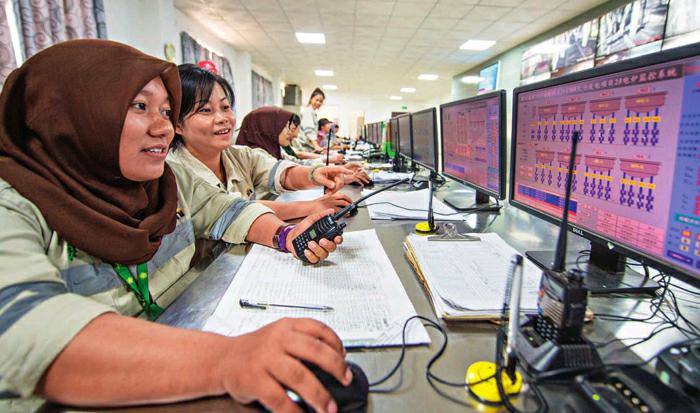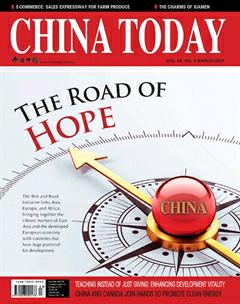The Global Impact of the Belt and Road Initiative
By+XIAO+HE
TO accurately evaluate the global impact of the Belt and Road Initiative, we should first understand what it is and how it affects the rest of the world, without speculating about whether China has ulterior motives behind the project.
Over the past three years, the initial ideas behind the Belt and Road Initiative have gradually been made concrete. The project has not only helped to improve the infrastructure of the countries involved, but has also had a psychological impact on the people living in those countries.
Although there are many different views concerning the initiative – which, it should be pointed out, hasnt yet been completed and is still very much in the process of development – this great strategy has begun to take shape on the Eurasian stage and has exerted a far-reaching influence on the future development of the whole world.
Improved Infrastructure
The Belt and Road Initiative, centered on boosting connectivity, aims to improve and enhance infrastructure in the countries and regions involved, in order to facilitate people-to-people exchanges and trade in commodities.
Worth noting is that the infrastructure mentioned in the initiative is not just roads, railways, ports, airports, telecommunications, and energy facilities, but also the construction of heavy industry. After all, the goal of enhancing connectivity is to strengthen the industrial capacity of those countries involved.
Many of the initiatives projects have attracted the attention of the international community, including the port of Gwadar in Pakistan, the port of Colombo and Hambantota deep-sea port in Sri Lanka, the China-Laos high-speed railway and the Suez Economic and Trade Cooperation Zone in Egypt. Some of them are still in the initial stages of planning and construction, some are in the final stages of developing and expanding, and some have already been completed.
The implementation of these large-scale projects has not only improved local infrastructure, but also boosted the overall industrial and social development of those countries. To evaluate the effect of these projects, we should take a look at the statistics on Chinas overseas investment.
Statistics released by the Chinese Ministry of Commerce showed that, in 2014, Chinese enterprises made a total of US $12.5 billion worth of non-financial investments in 49 countries within the cooperation framework of the Belt and Road Initiative. This figure climbed to US $14.82 billion in 2015. Between January and July 2016, Chinese enterprises made US $7.87 billion worth of investments in 51 Belt and Road countries – a drop of 8.4 percent year on year. So the total non-financial investment by Chinese enterprises since 2013 amounts to about US $50 billion, according to the authors calculation.
It should be noted that the figure from the Ministry of Commerce is far less than those offered by some other independent agencies. According to data from the China Global Investment Tracker, a project of the American Enterprise Institute for Public Policy Research (AEI), China invested a total of US$95 billion in countries along the Belt and Road routes from 2013 to June 2015. The statistics from the Center for American Progress, however, show that Chinas total investment by September of 2016 had reached US $250 billion.
This huge disparity is a product of different standards adopted when compiling statistics. For example, the Chinese Ministry of Commerce often excludes the volume of contracted projects. From January to July of 2016, Chinese enterprises signed contracts worth US $58.89 billion, representing a year-on-year growth of 19.1 percent. Considering that many contracted projects actually received financial support from the Chinese government, it is also reasonable to include the volume of contracted projects in the total investment made by China.
Other projects were not included in the abovementioned statistics for various reasons, such as the China-Belarus Industrial Park that was co-developed and operated by the two countries.
Despite these disparities in the statistics, China has invested heavily in the Belt and Road countries to help improve their local infrastructure and industrial capacity. Although the ability to utilize investment differs from country to country, the investment will eventually bear fruit; early achievements and substantial improvements to infrastructure in countries involved in the project have already proven the positive effects of the initiative.
Psychological Impact
Alongside the improvement in infrastructure, the initiative has also brought hope and opportunities to Belt and Road countries and the rest of the world.
The initiative pursues long-term return, which is difficult to visualize in the current climate of complications. What we can see clearly is high investment and high risk; as a result the initiative has triggered confusion, suspicion, and even objection. Some seem to suspect China of intending to expand the reach of its influence around the globe.
However, as projects have been implemented over the past three years, more and more countries see hope and opportunity in the Belt and Road Initiative and they are eager to participate in the cooperation framework.
Why is there hope? It goes without saying that improved infrastructure aids economic development and enables the flow of trade. Due to their natural environment and geopolitics, many countries and regions in Eurasia are unable to improve their local infrastructure and sharpen their industrial capacity by themselves using the current mechanism of international cooperation.
It is also difficult for those regions to improve their infrastructure by relying on market-based means that only pursue short-term economic returns. Meanwhile, the international community does not have a “government,” so it is impossible for it to support those countries and regions with public goods and investment. These problems have made it difficult for those countries to develop their economies.
The Belt and Road Initiative brings hope to those regions. In addition to providing financial support, the program fully taps the potential of these countries, enabling them to take action on their own initiative. Many countries are even more active than China in carrying out programs under the Belt and Road Initiative. Although some of the proposed plans are not easy to achieve, those countries discover that they can take action when they are given hope.
Why are there more choices? The mechanism currently used by the World Bank and the Asian Development Bank focuses more on avoiding risks and protecting the interests of investor countries, and is unable to meet the needs many counties have for financial support and economic development.
Through the Belt and Road Initiative, China has established a new mechanism, including the Asian Infrastructure Investment Bank, providing many practical choices for other countries. The debate on different ideas and proposals will push countries to work with each other and further reveal the potential of human wisdom in global governance.
An Initiative to Benefit the Globe
When evaluating the influence of the Belt and Road Initiative in the countries involved and the world at large, we should understand that this initiative is not the entirety of Chinas development strategy and outbound investment.
Chinas investment in Belt and Road countries actually peaked in 2007. Then, boosted by private investment, Chinas outbound investment surged again in 2016, mainly targeting traditionally developed countries, but not countries along the Belt and Road routes. According to data from the Ministry of Commerce, Chinas investment to North America and Oceania from January to May 2016 saw a yearon-year increase of 208 percent and 72.4 percent respectively, with investment to the U.S. at an all-time high. During the same period, Chinas investments in Asia, Latin America, and Africa grew by just 62.8 percent, 50.5 percent, and 5 percent respectively. Those figures show that China is comprehensively utilizing multiple means to boost its own development and offset any potential risks of investing in the projects under the Belt and Road Initiative.
In a sense, China is carrying out a large-scale cross-border development experiment by taking the risks itself. Its goal is to create a benign environment for its own development and prosperity, but the initiative also reveals Chinas sense of responsibility and its intention to pursue mutual benefits for all and long-term returns.
These goals can only be reached if government departments, enterprises and social organizations in China and the countries involved in the initiative can keep learning and improving themselves. There may be difficulties and challenges, but the Belt and Road Initiative is a project that can be of global benefit, as it provides more possibilities for Eurasia and the rest of the world.
- CHINA TODAY的其它文章
- Sci-Tech
- The Road of Hope
- Pakistan Showcases Achievements in Belt and Road Cooperation
- Enhancing Connectivity in East Africa: The Addis Ababa-Djibouti Railway
- Building Lifelines in Tajikistan–Tebian Electric Apparatus Stock Co.
- Chinese Projects Bring New Opportunities to Aktogay in Kazakhstan

